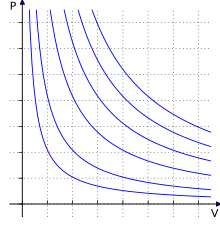
Back Idealegaswet Afrikaans قانون الغازات المثالية Arabic Llei de los gases ideales AST İdeal qazın hal tənliyi Azerbaijani Ураўненне стану ідэальнага газу Byelorussian Уравнение на Клапейрон – Менделеев Bulgarian আদর্শ গ্যাস সূত্র Bengali/Bangla Zakon idealnog plina BS Llei dels gasos ideals Catalan یاسای گازی نمونەیی CKB
| Thermodynamics |
|---|
 |

The ideal gas law, also called the general gas equation, is the equation of state of a hypothetical ideal gas. It is a good approximation of the behavior of many gases under many conditions, although it has several limitations. It was first stated by Benoît Paul Émile Clapeyron in 1834 as a combination of the empirical Boyle's law, Charles's law, Avogadro's law, and Gay-Lussac's law.[1] The ideal gas law is often written in an empirical form:
where , and are the pressure, volume and temperature respectively; is the amount of substance; and is the ideal gas constant. It can also be derived from the microscopic kinetic theory, as was achieved (apparently independently) by August Krönig in 1856[2] and Rudolf Clausius in 1857.[3]
- ^ Clapeyron, E. (1835). "Mémoire sur la puissance motrice de la chaleur". Journal de l'École Polytechnique (in French). XIV: 153–90. Facsimile at the Bibliothèque nationale de France (pp. 153–90).
- ^ Krönig, A. (1856). "Grundzüge einer Theorie der Gase". Annalen der Physik und Chemie (in German). 99 (10): 315–22. Bibcode:1856AnP...175..315K. doi:10.1002/andp.18561751008. Facsimile at the Bibliothèque nationale de France (pp. 315–22).
- ^ Clausius, R. (1857). "Ueber die Art der Bewegung, welche wir Wärme nennen". Annalen der Physik und Chemie (in German). 176 (3): 353–79. Bibcode:1857AnP...176..353C. doi:10.1002/andp.18571760302. Facsimile at the Bibliothèque nationale de France (pp. 353–79).


















